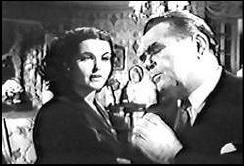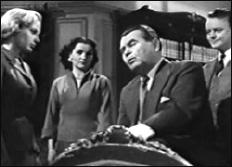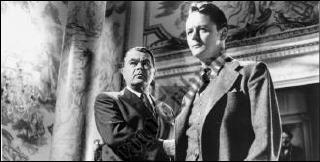REVIEWED BY DAVID VINEYARD:
HOUSE OF THE ARROW Associated British Pictures, UK, 1953, Oskar Holmoka, Yvonne Furneaux, Robert Urquhart, Josephine Green, Harold Kasket, Pierre Le Fevre. Screenplay by Edward Dryhurst, based on the novel by A. E. W. Mason. Directed by Michael Anderson.

Alfred Edward Wooley Mason was a bestselling novelist whose works included such classic tales of adventure and mystery as The Four Feathers, No Other Tiger, Sapphire, Fire Over England, The Drum, and stories such as “The Crystal Trench†(adapted on Alfred Hitchcock Presents with Hitchcock himself directing); a literary icon whose circle of friends and collaborators in theater included Henry James, Joseph Conrad, Ford Maddox Ford, Anthony Hope Hawkins (The Prisoner of Zenda), and Stephen Crane; an agent of British Naval Intelligence whose pre-WWI Spanish network would still be functioning successfully, and much to the benefit of the Allies, in the Second World War and into the post War era; and, perhaps most importantly here, the author of five acclaimed mystery novels and one short story featuring Inspector Hanaud of the Sureté who was the inspiration for Agatha Christie’s Hercule Poirot and his “little gray cells.â€
House of the Arrow is perhaps the most famous of the Hanaud novels, as evidenced by it having been filmed three times, first in 1930 with Benita Hume and Dennis Nielson-Terry as Hanaud; then in 1940 with Diana Churchill and Kenneth Kent as Hanaud; and, finally, this version in 1953 with Yvonne Furneaux and Oscar Holmoka as Hanaud.

This version, updated to modern post-war France begins in Dijon in the Burgundy region of France where Jeanne Marie Harlowe, an elderly and sickly widow, has just died apparently in the natural order of things. At the reading of her will Madame Harlowe leaves her fortune and estate to her adopted daughter Betty (Yvonne Furneaux) much to the consternation of her brother-in-law, from her first marriage Boris Waberski (Harold Kasket), who believes the fortune should go to him.
Shortly afterward Waberski makes a formal accusation against Betty of having murdered her adopted mother, prompting Betty’s companion, Englishwoman Ann Upcott (Josephine Green), to write Betty’s British solicitor for help.

Responding is Jim Frobisher (Robert Urquhart) who arrives in Paris to talk with the officer of the Sureté assigned the case, Inspector Hanaud (Oskar Holmoka, dapper rather than rumpled for once, even the famous eyebrows tamed), who seems quite surprised his upcoming visit to Dijon is known since he only just decided to go.
Hanaud settles the phony case brought by Waberski in short order, but things aren’t as they seem, he is certain of one thing: “If murder was done I mean to know, and I mean to avenge.†And what with a mysterious seller of illicit chemicals, accusing letters popping up everywhere, mysterious voices, and a missing arrow — it’s waxed point preserving an exotic untraceable poison — it becomes clear Hanaud has every reason to be suspicious.
What, if anything does the empty house next door, once occupied by the Germans, have to do with the mysterious goings on? Who is writing the poison pen letters and why? Why are the two young women so secretive? Whose voice did Ann hear the night of the murder, and why does the clock she saw seem smaller in daylight? Where is the mysterious poisoned arrow Hanaud discovered referenced in a book from the Harlowe library at the drug sellers business?

When a second murder, that of the seller of illicit drugs, occurs Hanaud must act fast before a third murder and injustice can further complicate matters.
Mason’s longish novel is savagely condensed, but thanks to atmospheric direction by Michael Anderson (Around the World in 80 Days), good use of shadow and light and clever but unobtrusive camera angles in limited but well done sets, above all Holmoka’s delightful turn as the vain, brilliant, playful, and very Gallic Hanaud, and a script that manages to keep things mostly clear in the mind of the viewer while still preserving a few surprises, this is a superior mystery film.
Though, as in the novel, and in many mystery novels and films, Hanaud causes quite a bit of the tension himself by revealing so little, but at least in this one with some justification.
I first read of this film ages ago in William K. Everson’s The Detective in Film, and it has taken me forty some years to catch up with it, but it proved well worth it. House of the Arrow is a wry, intelligent, atmospheric, fast paced, mystery with a tour de force performance by Oskar Holmoka as Hanaud. Whatever its minor flaws, they are more than compensated for by the films intelligence, wit, and fidelity to the spirit if not the exact word of Mason’s classic novel.
If you are looking for a fine adaptation of a classic mystery novel ably brought to the screen with skill and wit, you could not do better.




